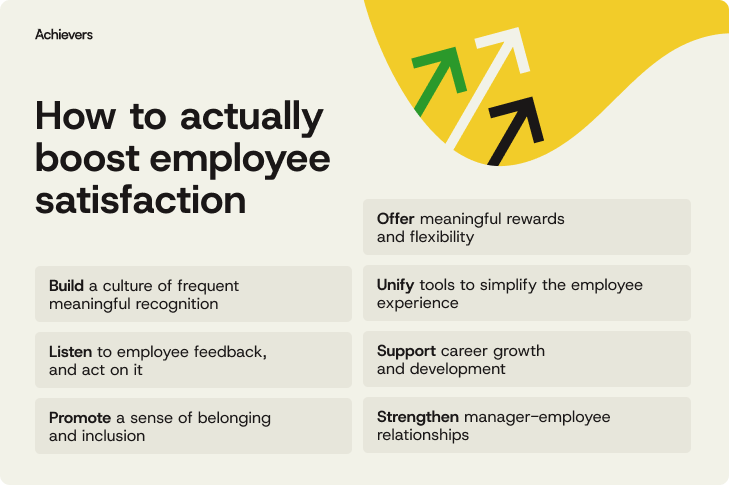Table of contents
Employee satisfaction isn’t just about smiley surveys and casual Fridays — it’s the backbone of a thriving, resilient workforce. When people feel valued, they bring their best selves to work, stick around longer, and maybe even stop fantasizing about quitting via interpretive dance in the breakroom.
And yes, the numbers agree: Gallup reports that highly engaged teams are 23% more profitable, while the Achievers Workforce Institute (AWI) found that employees who feel recognized are more than twice as likely to be engaged. That’s not just good for morale — it’s good for business.
In this post, we’ll walk through seven practical (and surprisingly simple) ways to boost employee satisfaction in 2025. And because juggling spreadsheets, Slack messages, and three different HR tools isn’t your idea of a good time, we’ll also show how solutions like Achievers make recognition and rewards seamless — and even a little fun.
Trust us: your future, more satisfied workforce will thank you.
What employee satisfaction really means (and why it matters)
Let’s clear something up: employee satisfaction isn’t just about snacks in the breakroom or whether the office chairs swivel just right. While perks are nice (who doesn’t love a surprise donut?), true satisfaction runs deeper. It’s about purpose, recognition, belonging, and growth. When people feel valued and supported, they’re more engaged, productive, and likely to stick around — simple as that.
Key drivers like frequent recognition, timely feedback, a strong culture, and development opportunities all play a role. And while most companies check the box with an annual survey, Achievers takes a different approach — focusing on daily employee experience through real-time feedback and recognition that actually makes an impact.
Because true satisfaction isn’t a moment — it’s a mindset.
7 proven ways to improve employee satisfaction
So, how do you move the needle on employee satisfaction without resorting to ping-pong tables or mandatory fun? Here’s how organizations can boost satisfaction — practically and sustainably — with help from employee rewards and recognition software like Achievers.
These seven strategies are grounded in what employees actually want (hint: it’s not another corporate mug) and designed to create lasting impact through meaningful, everyday moments. Let’s dive in.

1. Build a culture of frequent, meaningful recognition
Recognition isn’t just a feel-good bonus — it’s a fundamental driver of employee satisfaction. When people feel seen and appreciated, they’re more motivated, more engaged, and far less likely to daydream about working somewhere else.
The best recognition is public, timely, peer-driven, and aligned to company values (read: no generic “good job” emails). With Achievers, organizations can deliver points-based and social recognition at scale, making appreciation part of the everyday workflow — not just a once-a-year event.
2. Listen to employee feedback — and act on it
Feedback shouldn’t gather dust in a spreadsheet somewhere. Regular check-ins and pulse surveys show employees that their voices matter — and more importantly, that their input drives real change.
Achievers offers always-on, science-backed feedback tools that combine human insight with AI-powered analysis. So, you can hear what your employees are saying — and actually do something about it.
3. Promote a sense of belonging and inclusion
Feeling like you belong at work isn’t a luxury — it’s a key part of feeling satisfied and staying engaged. When employees feel accepted, respected, and connected, their loyalty (and job satisfaction) goes way up.
From employee resource groups to inclusive recognition campaigns, there are countless ways to foster connection. Achievers weaves DEI and belonging into the fabric of recognition, reinforcing inclusive values in every shout-out and celebration.
4. Offer meaningful rewards and flexibility
A one-size-fits-all gift card? Pass. Employees are more satisfied when they’re rewarded with options that actually matter to them — whether that’s a new gadget, a wellness perk, or the freedom to work in fuzzy slippers from home.
With Achievers’ reward marketplace, employees get access to millions of global, personalized rewards — and companies can offer modern “perks” like flexible scheduling without adding complexity. Satisfaction, meet scalability.
5. Support career growth and development
No one wants to feel stuck in a career cul-de-sac. Offering stretch assignments, mentorship, and training shows employees you’re invested in their future — not just their current role.
Achievers helps reinforce growth by enabling recognition tied to skill development and learning milestones — making professional growth something worth celebrating, not just tracking.
6. Strengthen manager-employee relationships
Let’s be honest: a great manager can make a job feel like a dream — and a bad one can make even dream jobs feel like a trap. That’s why manager relationships are critical to day-to-day satisfaction.
Encourage regular 1:1s, clear expectations, and coaching over command. With Achievers, managers can access real-time recognition and feedback data to lead more effectively — and maybe even become the reason someone stays.
7. Unify tools to simplify the employee experience
Nothing kills satisfaction like tech whiplash. If employees need five logins just to say “thank you,” something’s broken.
Achievers integrates with the tools your team already uses — like Workday, Microsoft Teams, and Slack — so recognition, feedback, and rewards flow naturally, without friction. Because satisfaction shouldn’t require a scavenger hunt.
The business case for improving employee satisfaction
Investing in employee satisfaction isn’t just good for morale — it’s good for business. Satisfied employees are more productive, more innovative, and a lot less likely to polish up their LinkedIn profiles during lunch.
In fact, AWI data shows that companies with highly engaged employees see up to a 43% lower turnover rate. And that’s just the start. Higher satisfaction also drives better performance, stronger culture, and a more attractive employer brand — because happy employees tend to talk (and post) about it.
Achievers isn’t just a software solution — it’s a strategic partner in transforming the employee experience. By enabling recognition, feedback, and rewards at scale, Achievers helps businesses turn culture into a competitive advantage.
Because when your people feel great about coming to work, the business results tend to follow.
Employee satisfaction is a marathon, not a sprint
Employee satisfaction isn’t a one-and-done deal — it’s an ongoing commitment. Think of it like keeping a plant alive; occasional watering and sunlight (aka feedback and engagement) is key to keeping it thriving. And lucky for you, a tech-enabled strategy makes this process a lot easier, providing real-time insights and personalized rewards to keep your team engaged and happy.
So, if you’re ready to make satisfaction a continuous success story, let’s get started. Don’t wait — your happy, engaged workforce is just a click away!



